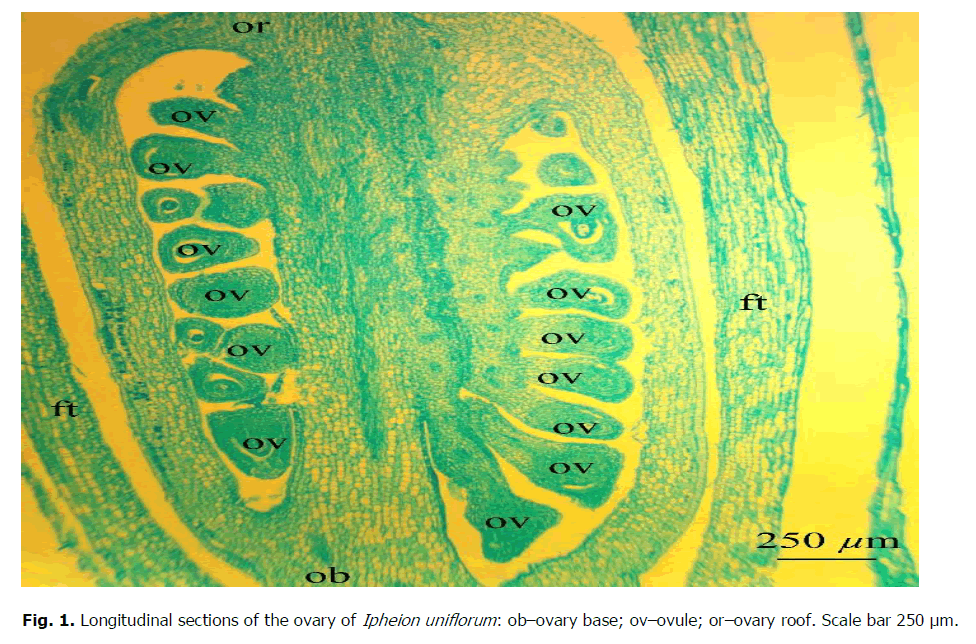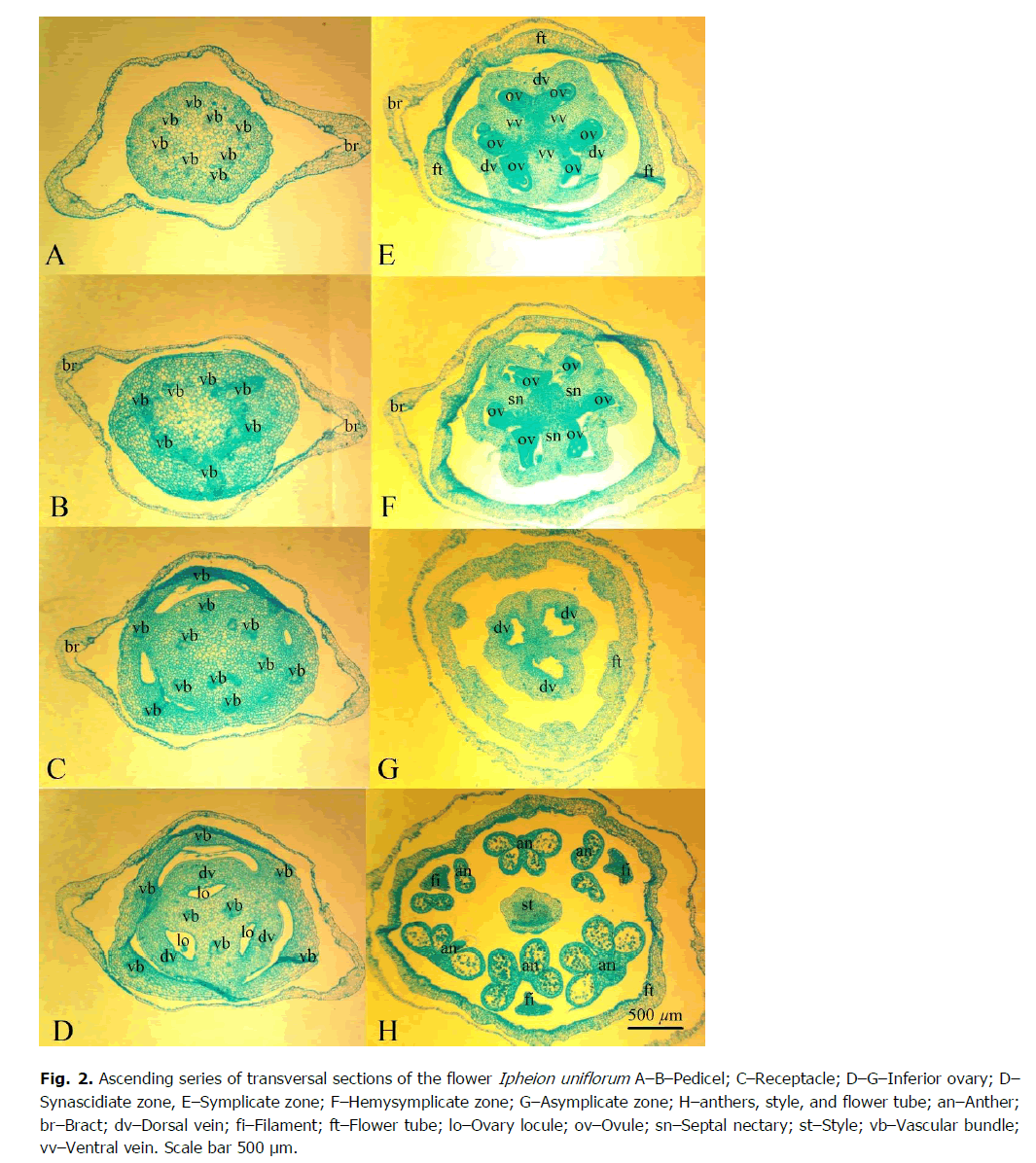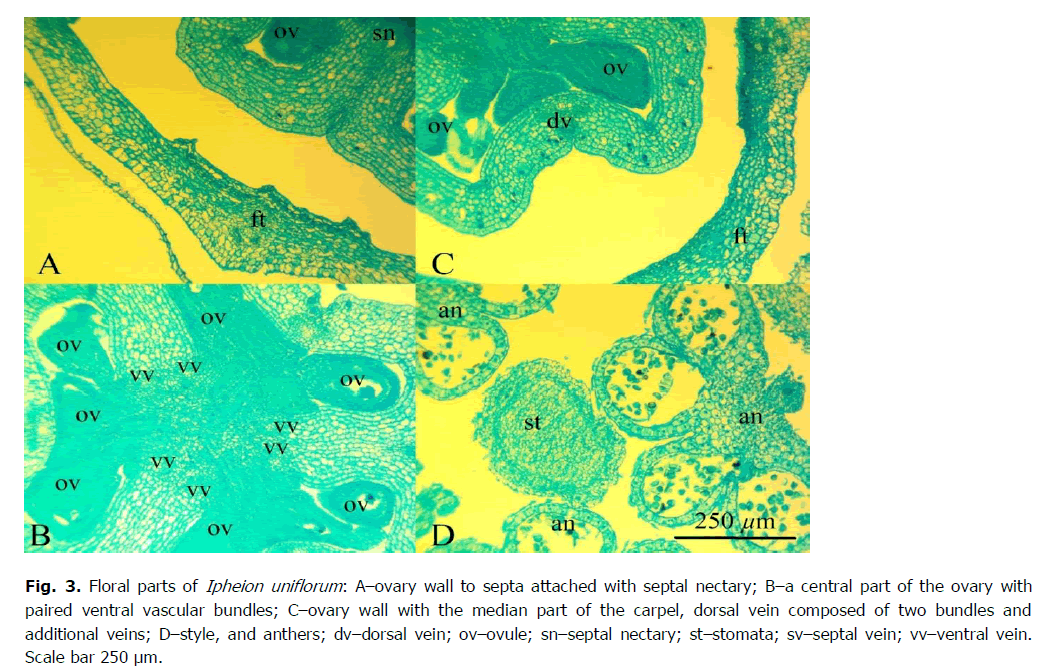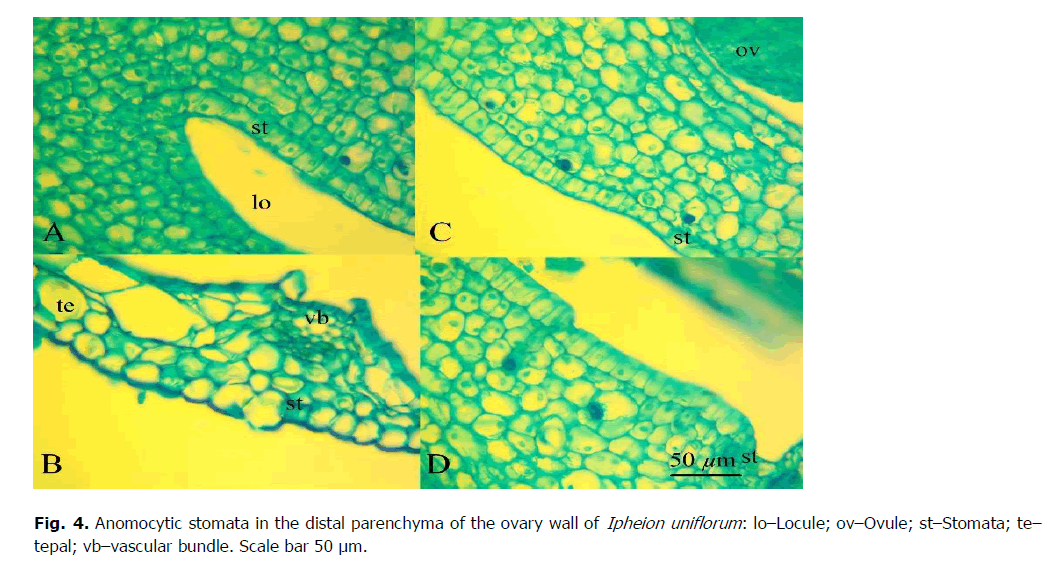Research - (2021) Volume 11, Issue 3
Morphology and vascular anatomy of the flower of Ipheion uniflorum (Raf.) Traub (Amaryllidaceae)
O. Fishchuk*Abstract
We studied the morphology and vascular anatomy of the flowers of Ipheion uniflorum. Anatomy and vascular anatomy, morphology, morphometric parameters of the ovary and the flower are described. We separated the following structural zones in the Ipheion uniflorum gynoecium: synascidiate, symplicate, hemisymplicate, and asymplicate. Septal nectaries appear in the hemisymplicate zone and have a height of about 800 μm. We identified the ovary zones according to W. Leinfelner and calculated the height of the ovary locules from the transverse sections.
Keywords
Cotton, fertilizers, yield, vegetative period.
Introduction
The study of morphological features of monocotyledonous flowers is becoming widespread on a level with molecular features (Odintsova & Fishchuk, 2017; Skrypec & Odintsova, 2020; Andreychuk & Odintsova., 2020). Morphological features of the flower, particularly the structure of the gynoecium, vascular anatomy, and the structure of septal nectaries, are essential for modern taxonomy because the new features can be used to build phylogenetic trees and thus impose morphological analysis to confirm or refute the results obtained by molecular data. The Amaryllidaceae family consists of three subfamilies, Agapanthoideae, Allioideae, and Amaryllidoideae (Chase et al., 2009). Representatives of the genus are found in Argentina, Uruguay, and southern Brazil, and they have naturalized all over the world and are used as ornamental plants (Meerow & Snijman, 1998).
The genus Ipheon belongs to the tribe Leucocoryneae, subfamily Allioideae of the family Amaryllidaceae J. St.-Hil. (Chase et al., 2016). M.F. Fay and M.W. Chase, in their molecular phylogenetic study of the rbcL gene, identified Gilliesioideae as a separate subfamily in Alliaceae (Fay & Chase, 1996). Gilliesia, Ipheion, Leucocoryne, Nothoscordum, and Tristagma formed Gilliesieae, this statement was accepted in Angiosperm Phylogeny Group (APG, 1998).
Subsequent phylogenetic analysis showed that Ipheion was not monophyletic. It is biphyletic, with some species clustering with Tristagma, and others with Nothoscordum (Fay et al., 2006); later sectional division was supported (Sassone et al., 2014). Souza L. G. R. and her colleagues (Souza et al., 2010) investigated Ipheon karyological circumscription and concluded that it is a separate genus of 3 species. Some sources do not allocate a separate genus but place all species of Ipheion in the Tristagma (World Checklist of Selected Plant Families). Ipheion section Hirtellum was raised to genus rank in (Sassone et al., 2014) under the older name of Beauverdia, with four species found in South America. This reply to Group 3 of the study Sassone et al. (2013). This retains the Ipheion section of Ipheion, which represents the genus (Sassone et al., 2013).
The loops and ultrastructure of the nucleolus of Ipheion uniflorum in ultrathin sections of root tips were studied by L. F. La Cour and B. Wells (La Cour & Wells, 1967). Determination of ploidy levels in Ipheion uniflorum (Meric & Dane, 2005) and Three New Furostanol Saponins from the Bulbs of Ipheion uniflorum (Nakamura, 1994) have been studied. Differences between genera and species Ipheion and Tristagma were outlined, a taxonomic survey with a new lectotype and consideration of the state of conservation of the studied species were presented (Sassone et al., 2021). The study of the genus is quite relevant, in particular, multivariate studies of Ipheion (Amaryllidaceae, Allioideae) and related genera (Sassone et al., 2013) and lectotypification and correct author citation of Ipheion uniflorum (Amaryllidaceae), with a new synonym author affiliation (Sassone et al., 2017), the new constituency of the Leucocoryneae tribe (Sassone et al., 2014). G. Souza et al. (2016) characterized the karyotype of Zoellnerallium and evaluated the phylogenetic relationships among the genera of Leucocoryneae (Souza et al., 2016).
The study of the internal structure of the gynoecium and the fetus is a significant area of research (Odintsova et al., 2014; Fishchuk & Odintsova, 2020; Andreychuk & Odintsova, 2020). The study aims to research the flower morphology features and identify the vertical ovary zones and vascular anatomy of the gynoecium in Ipheon uniflorum.
Materials and Methods
Ten flower buds of Ipheon uniflorum were dehydrated in t-butanol series (20%, 30%, 50%, 70%, 100% - 2 h each, the last one 24 h) and stored in 100% t-butanol and paraplast in the ratio 1:1. Infiltration was performed using Paraplast (Merck®) according to manufacturer's instructions and R. P. Barykina (Barykina et al., 2004). Transverse and longitudinal sections of 20 µm thickness were obtained with a manual rotary microtome (MPS - 2 (USSR)) and stained with Safranin and Astra Blau (Merck®). Slides were mounted in synthetic resin "Eukitt®" (Sigma-Aldrich®), and images were obtained with an AMSCOPE 10MP digital camera attached to a microscope AMSCOPE T490B-10M (USA). We used the concept of gynoecium vertical zonality by W. Leinfellner (Leinfellner, 1950) to analyze the gynoecium's internal structure, which considers only the congenital fusion of the carpels. According to this concept, with the growth of the carpels, in the syncarpous gynoecium, congenital multilocular synascidiate, unilocular simplicate, transitional hemisymplicate, and asymplicate (apocarpous) zones form. In the condition of incomplete fusion of carpels, a hemisyncarpous gynoecium with hemisynascidiate, hemisimplicate and asymplicate zones form only in their external part; later, the method was elaborated for monocots (Odintsova, 2013). The height of the gynoecium vertical zones was obtained after the calculation of the transverse sections of the pistil.
Results
Ipheon uniflorum flower is up to 3.2-3.5 cm long, white, and has a strong aroma. The scape is 20-21.6 cm long and 0.4 cm in diameter at the base and 0.2 cm above. There are two fused bracts with two keels which envelop the peduncle completely. They are membranous with purple stripes, about 3.2 cm long, at the base in a width of 0.4 cm, above 0.6 cm, and taper to the top. The pedicel is 5.2 cm long, 0.2 cm in diameter. The perianth is simple, six-membered, forming a jug-shaped flower tube 1.2 cm long and at the base 0.4 cm in diameter and 0.6 cm in diameter higher. Outer tepals are 2.2 cm, 2.5 cm, 2.3 cm long and 1.2 cm, 1.3 cm, 1.2 cm wide and the inner tepals are 2 cm, 2.1 cm, 2.1 cm and 1.1 cm wide, 1.2 cm, 1.1 cm, respectively. Flower tubes and perianth leaves in the middle have brown-purple stripes.
Stamens in Ipheon uniflorum are grown to the perianth tube, free at the top. The stamens of the inner circle are longer than the stamens of the outer circle, 1 cm long and 0.1 cm in diameter and the stamens of the outer circle are 0.7 cm long and 0.1 cm in diameter (Fig. 3D). Filaments are fusiform. Anthers are linear; on the outer and inner stamens, the anthers are 0.2 cm long and 0.1 cm in diameter. They are attached to the filaments below the middle of their height.
Ovary in Ipheon uniflorum is superior, three-loculed, oval, 0.5 cm high, and 0.3 cm in diameter with many ovules (Fig. 1). The style is filamentous and has a central arrangement 0.6 cm high and 0.1 cm in diameter (Fig. 2, H). Stigma is 0.1 cm long and 0.1 cm in diameter. There were stomata in the upper part of the peduncle, at the base of the flower tube, in the ovary wall, and the free tops of the tepals (Fig. 4). In Ipheon uniflorum ovary, we distinguish the following structural zones: a sterile synascidiate structural zone (Fig. 2D) about 680 μm high and a fertile symplicate structural zone about 1800 μm high (Fig. 2E) a hemisymplicate zone about 600 μm high (Fig. 2F) and asymplicate zone 140 μm (Fig. 2G). Septal nectaries appear along the hemisymplicate zone, and the total height of the septal nectary is 600 μm (Fig. 3A). The ovary roof is 200 microns. The ovary base is 300 microns (Fig. 1).

Figure 1: Longitudinal sections of the ovary of Ipheion uniflorum: ob–ovary base; ov–ovule; or–ovary roof. Scale bar 250 μm.

Figure 2: Ascending series of transversal sections of the flower Ipheion uniflorum A–B–Pedicel; С–Receptacle; D–G–Inferior ovary; D– Synascidiate zone, E–Symplicate zone; F–Hemysymplicate zone; G–Asymplicate zone; H–anthers, style, and flower tube; an–Anther; br–Bract; dv–Dorsal vein; fi–Filament; ft–Flower tube; lo–Ovary locule; ov–Ovule; sn–Septal nectary; st–Style; vb–Vascular bundle; vv–Ventral vein. Scale bar 500 μm.

Figure 3: Floral parts of Ipheion uniflorum: А–ovary wall to septa attached with septal nectary; B–a central part of the ovary with paired ventral vascular bundles; C–ovary wall with the median part of the carpel, dorsal vein composed of two bundles and additional veins; D–style, and anthers; dv–dorsal vein; ov–ovule; sn–septal nectary; st–stomata; sv–septal vein; vv–ventral vein. Scale bar 250 μm.

Figure 4: Anomocytic stomata in the distal parenchyma of the ovary wall of Ipheion uniflorum: lo–Locule; ov–Ovule; st–Stomata; te– tepal; vb–vascular bundle. Scale bar 50 μm.
The vascular system of the peduncle in Ipheon uniflorum consists of 14 large and small vascular bundles (Fig. 2, A-B), which unite above and form a vascular cylinder, from which at the level of the receptacle depart traces of dorsal bundles of the perianth (Fig. 3C) and traces of tepals, which above give rise to stamens traces. In the septa, there are two massive vascular bundles, which higher give branches to the center of the ovary, forming a large number of small vascular bundles - the roots of the ventral complex (Fig. 2, D), which above the level of locules are reorganized into three paired vascular bundles and supplied the ovules - ventral bundles of the carpel (Fig. 3B).
There are 8-10 ovules in each locule; the ovule traces are single-bundle. Dorsal vascular bundles of a carpel are three-bundle. Above the locules, the ventral bundles of the carpel merge with the dorsal bundles to form a dorsal vein. Traces of outer tepals and inner tepals are single bundle. Traces of stamens are single bundle.
Discussion
Ipheion uniflorum contains methyl-, propyl-, and ethylalliin. The characteristic alliaceous odor is present in Ipheion and Tristagma. The pollen of Ipheion is sulcate and reticulate. The mean length of the pollen is between 30 and 45 fxm, and the sulcus does not reach the proximal side of the pollen grain. There are two bracts in Ipheion uniflorum flower united at one side for about 1/2 their length, at the other for more. Flowers are solitary, rarely 2, with tepals united for 1/3-2/3. Anthers are free from each other, inserted in the tepal tube at two levels (Meerow & Snijman, 1998).
Establishing species boundaries has been a challenge for biologists since the beginning of classification. Within the South American Allioideae (=Alliaceae), the delimitation of genera and species has long been a significant issue. Therefore, the nomenclature of the species level in these groups was difficult to determine. Tristagma and Ipheion are related genera, delimitations, and limitation of several species of which remain unclear. Tristagma sedentary, a species that inhabits the Andes and the coast of Chile, and Ipheion recurvifolium, a species native to Uruguay found only near sea level, are considered one of the species with an intracontinental disjunctive distribution. The differences in the habitats and distribution of these taxa have raised whether they are a single species. This study aims to elucidate the evolutionary relationships and status of the taxa of Chile and Pompeii. Scientists have analyzed the name Tristagma leichtlinii, which often causes controversy, and they concluded that the two taxa are different species that can be classified as separate genera. We hypothesize that Tristagma sessile and Ipheion recurvifolium's morphological similarity is sufficiently confirmed in this study, maybe similar features and the sum of common synapomorphies. Natural scientists update the biogeographical relation of the two genera and suggest that such pollinators may contribute to the convergence of floral traits (Sassone et al., 2021).
Ipheion uniflorum has tunicated bulbs with alliaceous odor; in bulbs, the starch is absent. Leaves are more or less unifacial. Corolla is basally connate, without corona. Stamens are basally connate and adnate to the corolla, often with winged filaments. The embryo is curved (Takhtajan, 2009).
According to W. Leinfelner (Leinfelner, 1950), the following structural zones are present in Ipheion uniflorum gynoecium: synascidiate, symplicate, hemisymplicate, and asymplicate. Septal nectaries appear in the hemysymplicate zone and extend to the entire height of the ovary and have a total height of about 600 μm.
In the peduncle of Ipheion uniflorum, there are 14 large and small vascular bundles, which unite above and form a vascular cylinder, from which at the level of the receptacle depart traces of dorsal bundles of perianth and traces of tepals. Higher they give rise to stamens traces. On the level of locules, the vascular bundles are reorganized into three paired vascular bundles and supply the ovules - ventral bundles of the carpel. There are 8-10 ovules in each locule; the ovule traces are single-bundle. Dorsal vascular bundles of a carpel are three-bundle. Above the locules, the ventral bundles of the carpel merge with the dorsal bundles to form a dorsal vein. Traces of outer tepals and inner tepals are single bundle. Traces of stamens are single bundle.
There is a constant debate about the genus location and its affiliation in the phylogenetic system. Moreover, by studying the features of the internal morphology of the flower and the features of vascular anatomy, it is possible to analyze the similarities and differences of such genera as Beauverdia, Ipheion, Leucocoryne, Nothoscordum, Tristagma, and Zoellnerallium in the tribe Leucocoryneae. The study of the external and internal structure of the fruit would make it possible to compare these species more accurately, because at the stage of the flower, the signs of the future fruit begin to be laid down, and without further study of the structure of the fruit we cannot explain the available features of flower.
Conclusion
Morphology and vascular anatomy features in Ipheion uniflorum give us the possibility to explain some morphological features formed at the flowering stage. We investigated the presence of four ovary vertical zones, and septal nectaries, the availability of 14 large and small vascular bundles in the peduncle of Ipheion uniflorum, vascular cylinder, ventral bundles of the carpel, dorsal vascular bundles of a carpel which are three-bundle, that feature is a disclosure of the future fruit just in between vascular bundles. This is a potential characteristic of the fruiting stage which is laid at the flowering stage. It allows us in the future to compare the features of related taxa for using them in the taxonomy of the subfamily Alliaceae.
Acknowledgement
The article is made within the framework of the state theme: "Comparative flower and fruit morphology in Amaryllidaceae J.St.-Hil. in connection with issues of taxonomy. "State registration number: 0120U101743.
References
Andreychuk, R., Odintsova, A. (2020). Actual state of carpological studies in the family Campanulaceae Juss. with regard to its systematics. Studia Biologica, 14:95–116.
Barykina, R.P., Veselova, T.D., Deviatov, A.G., Djalilova, H.H., Iljina, G.M., Chubatova, N.V. (2004). Spravochnik po botanicheskoy mikrotehnike. Osnovyi i metodyi [Handbook of the botanical microtechniques]. Moscow. Moscow State University.
Chase, M.W., Christenhusz, M.J.M., Fay, M.F., Byng, J.W., Judd, W.S., Soltis, D.E., Mabberley, D.J., Sennikov, A.N., Soltis, P.S., Stevens, P.F. (2016). The angiosperm phylogeny group. An update of the angiosperm phylogeny group classification for the orders and families of flowering plants APG IV. Botanical Journal of the Linnean Society, 181:1-20.
Chase, M.W., Reveal, J.L., Fay, M.F. (2009). A subfamilial classification for the expanded asparagalean families Amaryllidaceae, Asparagaceae and Xanthorrhoeaceae. Botanical Journal of the Linnean Society, 161:132–136.
Fay, M.F., Rudall, P.J., Chase, M.W. (2006). Molecular Studies of Subfamily Gilliesioideae (Alliaceae). Aliso: A Journal of Systematic and Floristic Botany, 22:367–371.
Fay, M.F., Chase, M.W. (1996). "Resurrection of Themidaceae for the Brodiaeaalliance, and recircumscription of Alliaceae, Amaryllidaceae and Agapanthoideae". Taxon. 45:441–451.
Fishchuk, O., Odintsova, A., Sulborska, A. (2014). Gynoecium structure in Dracaena fragrans (L.) Ker Gawl., Sansevieria parva N.E. Brown and Sansevieria trifasciata Prain (Asparagaceae) with septal emphasis on the structure of the septal nectary. Acta Agrobotanica, 66:55–64.
Fishchuk, O.S., Odintsova, A.V. (2020). Micromorphology and anatomy of the flowers of Galanthus nivalis and Leucojum vernum (Amaryllidaceae). Regulatory Mechanisms in Biosystems, 11:463–468. https://wcsp.science.kew.org/namedetail.do?name_id=279362
La Cour, L.F., Wells, B. (1967). The loops and ultrastructure of the nucleolus of Ipheion uniflorum. Zeitschrift für Zellforschung und Mikroskopische Anatomi, 82:25–45.
Leinfellner, W. (1950). The blueprint of the Synkarpen gynoceum. Austrian Botanical Journal, 97:403-436.
Meerow, A.W., Snijman D.A. (1998). Amaryllidaceae. In: Kubitzki, K., Huber, H., Rudall, P.J. Stevens, P.S., Studzel, T. (ed.). The families and genera of vascular plants. III. Flowering plants: Monocotyledons: Lilianae (except Orchidaceae) Springer, Berlin, рр:83– 110.
Meric, C., Dane, F. (2005). Determination of ploidy levels in Ipheion uniflorum (R.C. Graham) Rafin (Liliaceae). Acta Biologica Hungarica, 56:129–136.
Nakamura, O., Mimaki, Y., Sashida, Y., Nikaido, T., Ohmoto, T. (1994). Three New Furostanol Saponins from the Bulbs of Ipheion uniflorum. Chemical and Pharmaceutical Bulletin, 42:1116–1122.
Odintsova, A, Fishchuk, O. (2017). The flower morphology in three Convallariaceae species with various attractive traits. Acta Agrobotanica, 70:1705–1719.
Odintsova, A. (2013). Two main types of septal nectaries in monocotyledons. Visnyk Lvivskogo universytetu. Seriya Biologichna, 61:41–50.
Sassone, A.B., Giussani L. (2013). Molecular phylogeny of genus Ipheion (Amaryllidaceae, Alloideae) and related genera. Boletín de la Sociedad Argentina de Botánica, 48:272.
Sassone, A.B., Arroyo, M.T., Arroyo‐Leuenberger, S.C., García, N. Román, M.J. (2021). One species with a disjunct distribution or two with convergent evolution? Taxonomy of two South American garlics. Taxon.
Sassone, A.B., Arroyo-Leuenberger, S.C., Giussani, L.M. (2014). Nueva circunscripción de la tribu Leucocoryneae (Amaryllidaceae, Allioideae). Darwiniana, 2:197-206.
Sassone, A.B., Giussani, L.M. Guaglianone, E.R. (2013). Multivariate studies of Ipheion (Amaryllidaceae, Allioideae) and related genera. Plant Systematics and Evolution, 299:1561–1575.
Sassone, A.B., Giussani, L.M., Arroyo-Leuenberger, S. (2017). Lectotypification and Correct Author Citation of Ipheion uniflorum (Amaryllidaceae), with a New Synonym Author Affiliations. Annales Botanici Fennici, 54:99–103.
Souza, G. Crosa, O., Speranza, P., Guerra, M. (2016). Phylogenetic relations in tribe Leucocoryneae (Amaryllidaceae, Allioideae) and the validation of Zoellnerallium based on DNA sequences and cytomolecular data. Botanical Journal of the Linnean Society, 182:811–824.
Souza, L.G.R., Crosa, O., Guerra, M. (2010). Karyological circumscription of Ipheion Rafinesque (Gilliesioideae, Alliaceae). Plant Systematics and Evolution, 287:119–127.
Takhtajan, A. (2009). Flowering Plants. 2nd edition, Springer. The angiosperm phylogeny group. (1998). An ordinal classification for the Families of Flowering Plants (APG). Annals of the Missouri Botanical Garden, 85:531–553.
Author Info
O. Fishchuk*Citation: Fishchuk, O. (2021). Morphology and vascular anatomy of the flower of Ipheion uniflorum (Raf.) Traub (Amaryllidaceae). Ukrainian Journal of Ecology, 11 (3), 316-321.
Received: 25-May-2021 Accepted: 03-Jul-2021 Published: 24-Aug-2021, DOI: 10.15421/2021_178
Copyright: This is an open access article distributed under the terms of the Creative Commons Attribution License, which permits unrestricted use, distribution, and reproduction in any medium, provided the original work is properly cited.
